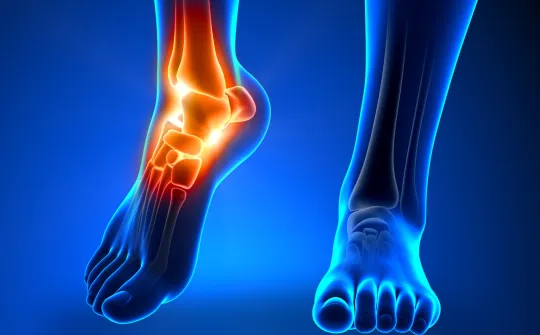
Ankle Arthroscopy for Arthritis, Bone Spurs, Fractures, and More
About the Ankle Joint
The ankle joint is made up of the tibia and the fibula, which are the leg bones, as well as the talus, or ankle bone. These are all connected with ligaments and tendons. These structures give the ankle its range of motion, allowing you to walk, run, and jump. When damage or injury occurs, mobility becomes limited. This can have a dramatic impact on your comfort and overall quality of life.

Dedicated Foot & Ankle Specialist
Dr. Andrew Ebert, our dedicated foot and ankle specialist, is trained to perform ankle arthroscopy. This advanced surgery employs an arthroscope, a thin flexible tube containing a camera and other instruments, to treat several types of conditions in the ankle joint. It is a minimally invasive approach that allows more rapid recovery compared to conventional methods. Dr. Ebert is board-certified surgeons who have extensive experience in arthroscopic procedures. They will take several measures to ensure your ankle procedure goes smoothly at our Cedar Park, Lakeway, and Austin, TX clinics and surgical centers.

Why Consider Arthroscopy?
Dr. Ebert can perform most surgeries on the ankle through arthroscopy. Rather than creating one or more large incisions to access the ankle joint, they can create just two small incisions. This minimizes scarring, reduces the risk of surgical infection, and allows for faster recovery. Patients who follow the post-operative instructions provided by Dr. Ebert can expect to see dramatic improvements in discomfort and range of motion following ankle arthroscopy.
What to Expect During the Procedure
Once you are comfortably sedated, Dr. Ebert will create two or more incisions on the ankle. In the first, they will insert the arthroscope, which contains a small camera. This will allow him a full view of the ankle without creating a large incision. To expand the joint for a better view, they will add a sterile saline solution. They will insert instruments through the other incision and work precisely to clear out any infected tissue, file down bone growths, repair damage, and more. Once they have repaired the ankle joint, they will carefully close the incisions.
Compared to traditional surgical methods, ankle arthroscopy can minimize scarring, reduce the risk of surgical infection, and allow for faster recovery.
Although arthroscopy provides patients with more rapid recovery than traditional surgical techniques, the healing process may still take several months. Individual recovery times vary based on the patient's overall health and physical activity levels. Your recovery may include physical therapy to restore full range of motion.